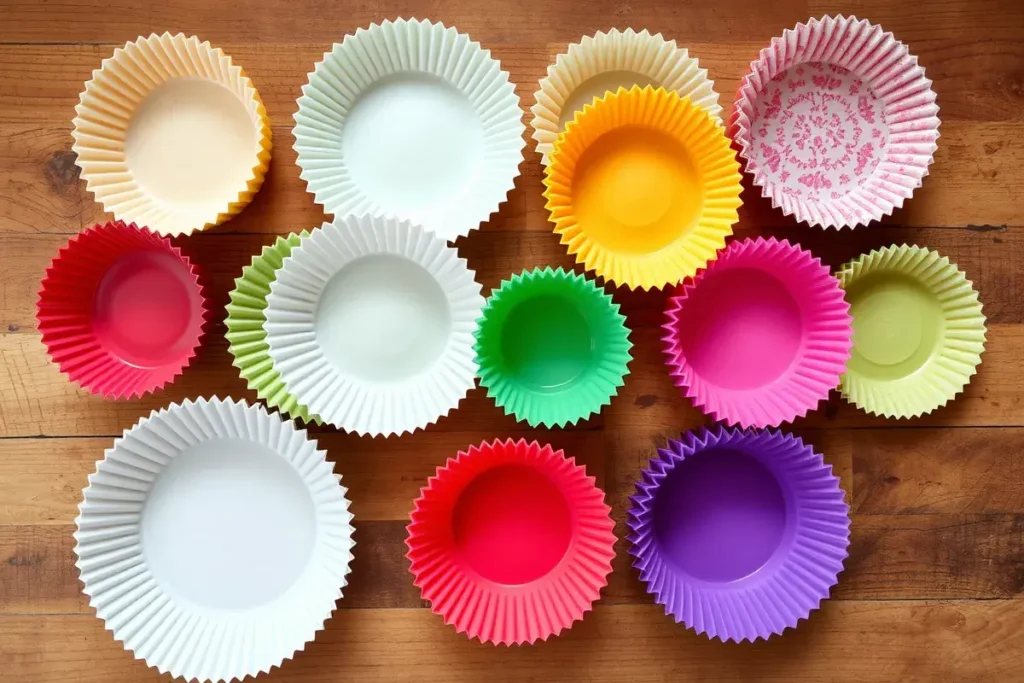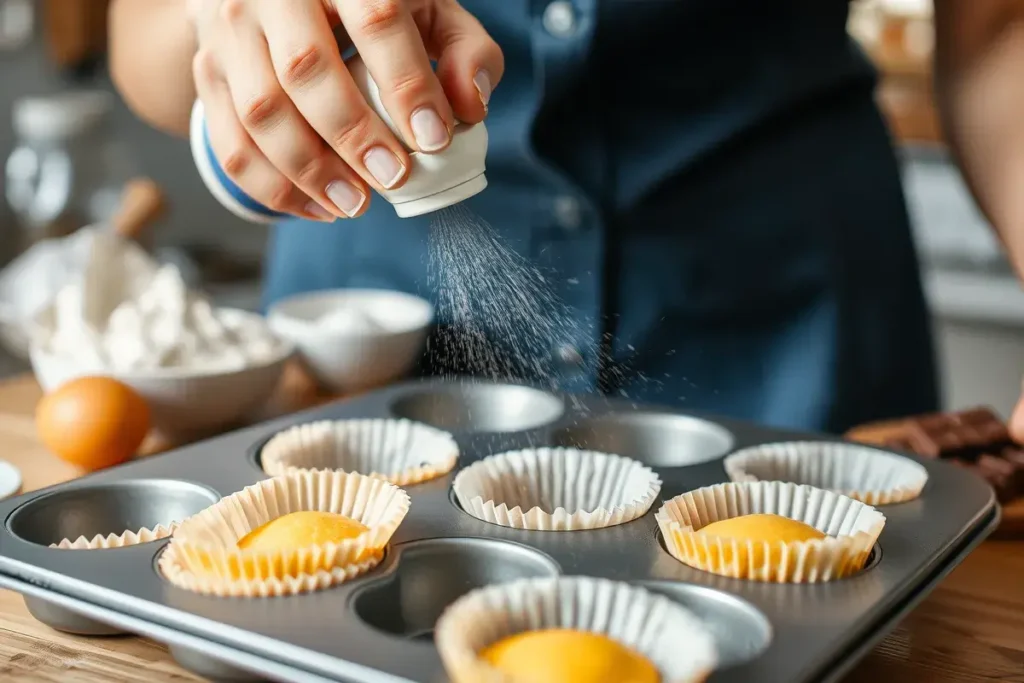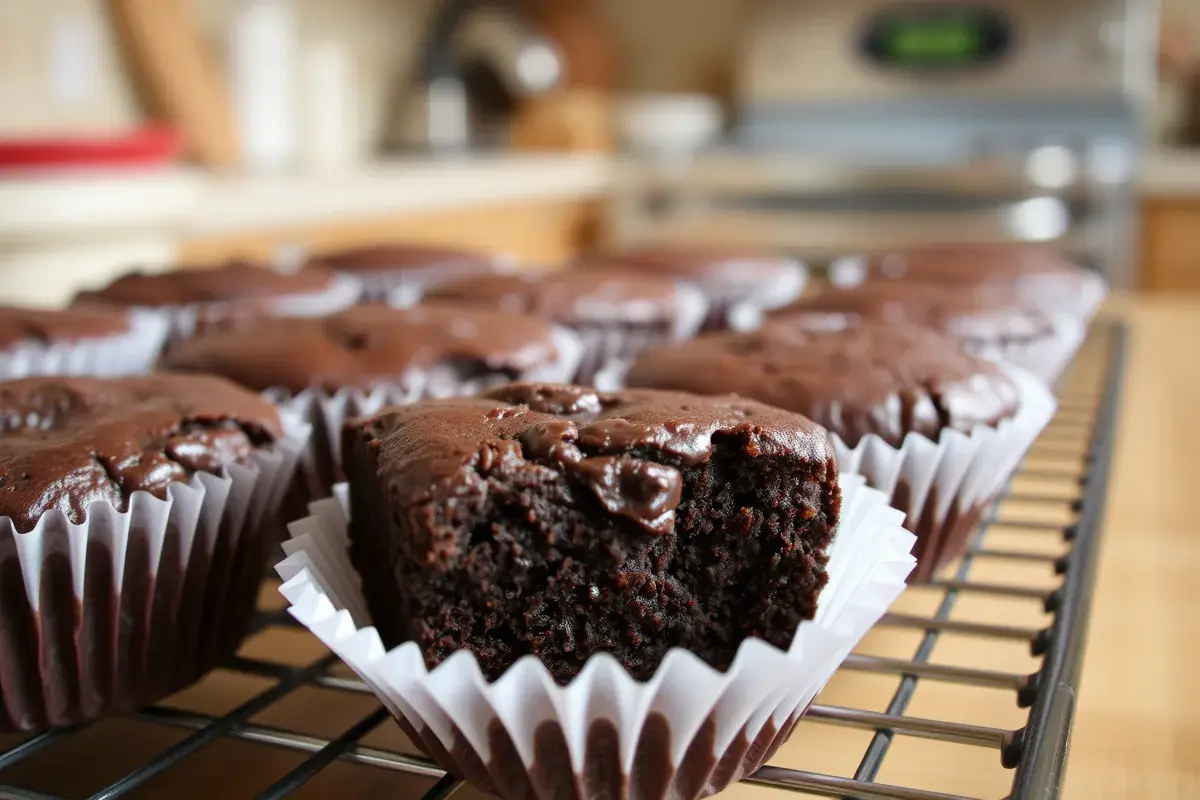Understanding the Role of Cupcake Liners in Baking Brownies
Purpose of Cupcake Liners
Cupcake liners are more than just decorative holders for your treats. They serve a functional purpose in baking, especially when making brownies. By providing a barrier between the batter and the muffin tin, cupcake liners help maintain the integrity of your baked goods. No more messy pans or sticking disasters!
These liners also ensure better hygiene by limiting direct contact with the pan. Plus, they make serving and storing brownies a breeze. Whether you’re baking for a party or a quick snack, using liners keeps things tidy and convenient.
Common Issues with Brownies Sticking to Liners
Despite their benefits, cupcake liners can sometimes be a source of frustration. Have you ever peeled a liner off a brownie only to have half the dessert stick to it? It’s disappointing and wasteful. This issue often arises due to the brownie batter’s texture and sugar content. Sticky liners are especially common with moist, fudgy brownies or recipes rich in sugar.
Fortunately, there are solutions! Spraying cupcake liners or using non-stick alternatives can significantly reduce sticking. We’ll explore this further in the coming sections, so you can achieve flawless brownies every time.
The Debate: To Spray or Not to Spray
Should You Spray Cupcake Liners for Brownies?
Ah, the eternal baking dilemma! The decision to spray or not to spray cupcake liners for brownies often sparks heated debates among bakers. On one hand, spraying liners ensures that every crumb of your decadent dessert releases smoothly. On the other, some argue that it’s unnecessary and might even compromise the final product. Let’s break it down to help you decide.
Arguments for Spraying Liners
Spraying cupcake liners offers several undeniable benefits, especially for gooey, rich brownie recipes. When you apply a light coat of non-stick spray, you create a barrier that prevents brownies from clinging to the liner. This ensures the dessert’s shape stays intact and eliminates the frustration of peeling away chunks of batter stuck to the paper.
Moreover, spraying can enhance the texture of brownies. Instead of losing those delicious edges to the liner, the sprayed barrier keeps them firm and intact, which is a treat for edge lovers! This is especially useful when working with recipes that include sticky add-ins like caramel or marshmallows. According to Baking How, spraying also helps avoid unnecessary crumbs during serving, making brownies presentable and mess-free.
Arguments Against Spraying Liners
While spraying seems like a foolproof solution, it’s not always the best approach. One downside is the potential greasiness that can seep into the brownie’s surface, altering its texture and taste. Over-spraying, in particular, can make the dessert overly oily, which is far from ideal.
Additionally, not all liners require spraying. Non-stick liners, such as silicone or parchment, are designed to release brownies effortlessly. Spraying these types of liners might be redundant and could even make them slippery. Plus, some bakers prefer the natural, slightly rustic texture created by liners alone, without any added grease. When using high-fat recipes, the butter or oil in the batter itself often provides sufficient release, eliminating the need for extra spray.
In the end, the choice boils down to personal preference, the type of liners used, and the nature of your brownie recipe!
Types of Cupcake Liners and Their Properties
Exploring Different Cupcake Liner Materials
Not all cupcake liners are created equal, and choosing the right type can significantly impact your baking experience. Whether you’re looking for cost-effective solutions or reusable options, understanding the properties of various liner materials is essential.

Paper Liners
Paper liners are the most common and affordable choice for home bakers. Found in almost any grocery store, they’re available in a variety of colors, patterns, and sizes. However, their affordability comes with a downside—brownies baked in paper liners tend to stick more than with other options. Without a non-stick coating, the paper often clings to moist batters, especially those rich in sugar. Spraying these liners with a light mist of non-stick spray can help resolve this issue, ensuring a cleaner release.
Foil Liners
Foil liners, known for their shiny appearance, offer an upscale alternative to paper. Their sturdiness means they can often stand alone without the support of a muffin tin. Thanks to their inherent non-stick properties, foil cupcake liners generally don’t require spraying. However, for extra assurance—especially with dense brownie batters—a quick spray can prevent any rare sticking. They’re perfect for presenting desserts in a polished way without compromising functionality.
Silicone Liners
Silicone liners have gained popularity for their reusability and practicality. Made from food-grade silicone, these liners are naturally non-stick, which means you can skip the spray altogether. Silicone liners are also environmentally friendly and can withstand repeated use, saving money over time. Another perk? Brownies pop out effortlessly, maintaining their shape and structure, making them an excellent choice for sticky or gooey recipes.
Parchment Liners
Parchment liners are a baker’s secret weapon. They’re essentially small sheets of parchment paper shaped to fit muffin tins. These liners excel at preventing sticking without the need for added spray or grease. Their unassuming appearance belies their effectiveness, making them a favorite for professional bakers and home enthusiasts alike. The parchment surface ensures brownies slide right out, clean and perfect, every time.
Best Practices for Preparing Cupcake Liners
How to Properly Spray Cupcake Liners
Mastering the art of spraying cupcake liners is a small but crucial step for perfect brownie results. When done correctly, it ensures clean release, preserves texture, and enhances the overall presentation.
Choosing the Right Non-Stick Spray
Not all sprays are created equal. When selecting a non-stick spray for cupcake liners, opt for one specifically labeled for baking. These sprays are designed to handle high heat without altering the flavor of your treats. Avoid sprays with added flavors unless they complement your brownies. For example, coconut oil sprays can add a mild tropical note, while standard vegetable sprays maintain neutrality.
Step-by-Step Spraying Technique
- Begin by placing the cupcake liners in the muffin tin. Make sure they’re properly seated to prevent batter from seeping underneath.
- Hold the spray can about 6–8 inches away from the liners. This distance ensures even coverage without oversaturating any one area.
- Lightly mist the inside of each liner with a quick burst of spray. Avoid drenching the liners, as too much oil can seep into the batter, creating a greasy texture.
- After spraying, let the liners sit for a few moments to allow excess oil to settle. This step prevents uneven distribution once the batter is added.
- Pour your brownie batter into the liners as usual and bake to perfection!
Following this simple method guarantees that your liners are just greasy enough to release the brownies without causing unwanted changes in texture.

Alternative Methods to Prevent Sticking
If you’d rather skip the spray, there are several effective alternatives:
- Brushing with Butter: Melted butter adds a rich flavor to the edges of your brownies and acts as a natural barrier. Use a pastry brush to lightly coat the liners.
- Using Oil: Dab a small amount of neutral oil (like vegetable or canola) on a paper towel and wipe it around the inside of the liners. This technique is less messy than spraying and avoids over-greasing.
- Lining with Parchment Rounds: For a DIY solution, cut small circles from parchment paper and place them inside the liners. This extra layer prevents sticking without additional fat.
Whether you choose spray, butter, or parchment, these approaches make peeling away liners effortless while keeping your brownies intact!
Factors Influencing the Need to Spray Liners
Recipe Considerations
The decision to spray cupcake liners often depends on the type of brownie recipe you’re working with. Elements like fat and sugar content significantly affect whether liners stick or release cleanly. Let’s explore these factors to understand how they influence your baking process.
High-Fat vs. Low-Fat Brownie Recipes
Brownies with a higher fat content—thanks to ingredients like butter, oil, or chocolate—naturally have better release properties. The fats act as a lubricant, reducing the likelihood of the batter clinging to liners. In these recipes, spraying cupcake liners might be optional unless you’re using basic paper liners.
On the other hand, low-fat brownies, often made with substitutions like applesauce or yogurt, lack the greasiness that aids in easy release. These recipes tend to stick more, especially if paired with plain paper liners. In such cases, lightly spraying the liners can help avoid unnecessary sticking and preserve the integrity of the dessert.
Sugar Content and Its Effects
Sugar plays a pivotal role in baking, not just for sweetness but also in how it caramelizes during cooking. Recipes with high sugar content can cause the batter to become sticky, especially near the edges where it meets the liner. This is why brownies rich in sugar frequently stick, even when using foil or non-stick liners.
Spraying liners creates a barrier that minimizes the effects of caramelization. Without this step, you may find yourself peeling bits of brownie off the liner, wasting the tastiest parts! However, if your recipe has moderate to low sugar, the need for spraying diminishes, as there’s less risk of sticking.
Pros and Cons of Spraying Cupcake Liners
Evaluating the Advantages and Disadvantages
Like any baking technique, spraying cupcake liners comes with its share of benefits and drawbacks. Let’s weigh both sides to help you decide if this step is worth it for your next brownie batch.
Benefits of Spraying Liners
Spraying liners can make your baking experience smoother, especially for gooey brownies. The most obvious advantage is ease of removal. A light mist of non-stick spray ensures the liners peel away cleanly, leaving your brownies intact and visually appealing.
Another perk is the improved presentation. With sprayed liners, there’s no tearing or sticking, which means your brownies maintain their shape—an essential factor for parties or professional baking. Plus, it reduces wastage. Every bite stays on the plate instead of the liner! For recipes with sticky add-ins like caramel or fruit, spraying is almost a necessity to avoid frustration and ensure every element shines.
Potential Drawbacks of Spraying Liners
While spraying can be helpful, it’s not without its downsides. Over-spraying can make liners excessively greasy, which might affect the texture of your brownies. Instead of crisp edges or a chewy bite, you might end up with an overly oily finish.
Additionally, spraying liners can sometimes alter the flavor subtly, especially if the spray isn’t neutral. Coconut or butter-flavored sprays, for instance, might clash with the recipe. Lastly, if you’re using non-stick liners, the spray could be redundant, leading to unnecessary mess and cost. Over time, these small inconveniences may outweigh the benefits for some bakers.
The key is to assess your specific recipe and liner type before reaching for that spray can!
Expert Opinions and Recommendations to spray cupcake liners for brownies
Insights from Professional Bakers
Professional bakers have a wealth of experience when it comes to baking brownies, and their opinions on spraying cupcake liners provide valuable insights. Many emphasize that the decision depends largely on the type of liner and the nature of the recipe. For instance, bakers working with moist, sugar-heavy batters often swear by a light spray to prevent sticking, ensuring clean removal without sacrificing presentation.
A survey conducted among professionals revealed that about 70% of them use non-stick sprays for paper liners when baking sticky desserts like brownies. They highlighted that skipping this step often leads to uneven peeling, leaving chunks of brownie behind. On the flip side, bakers who frequently use silicone liners or parchment paper find spraying unnecessary. They argue that these materials are already designed for effortless release.
Consensus and Best Practices
The consensus among expert bakers is simple: tailor your approach to the tools and recipe. For plain paper liners, a quick mist of spray is highly recommended, especially when dealing with sticky or gooey recipes. However, when using high-quality non-stick liners or recipes with a high-fat content, skipping the spray usually works just fine.
Another key takeaway is to avoid over-spraying. Professionals caution against using too much oil, which can lead to greasy liners and altered textures. Instead, they suggest holding the spray can a few inches away for even and minimal coverage. Their best practice advice? Test your liners with a small batch first to find the method that works best for you!
Frequently Asked Questions (FAQs) about spray cupcake liners for brownies
Addressing Common Queries
Curious about spraying cupcake liners? Here are answers to some of the most frequently asked questions, straight from the baking community.
No, non-stick cupcake liners are designed to release baked goods easily without additional grease. However, if your recipe includes sticky ingredients like caramel, a light spray can provide extra assurance.
Yes, alternatives like melted butter, oil applied with a brush, or even parchment paper work well. These methods offer a natural, effective way to prevent sticking without altering flavor.
If you’re skipping liners, greasing the pan with butter or oil and lightly dusting it with flour or cocoa powder creates an effective non-stick surface.
Spraying liners doesn’t typically affect baking time or temperature. However, using too much spray might alter the texture slightly, so keep the application light for optimal results.
Conclusion of spray cupcake liners for brownie
Making an Informed Decision
When it comes to the question Do you spray cupcake liners for brownies?, the answer ultimately depends on several key factors. Your recipe type, the liner material, and even your personal baking preferences all play a role in determining whether spraying is necessary. While some recipes and liners benefit from a quick mist of non-stick spray, others work perfectly without it.
By understanding the unique properties of your tools and ingredients, you can make a decision that guarantees the best results every time. Whether you’re aiming for picture-perfect edges or simply trying to avoid sticking disasters, a little knowledge goes a long way in perfecting your brownies.
Weighing the Factors
For sticky brownie batters or standard paper liners, a light spray can make peeling off the liner a breeze. However, if you’re using high-fat recipes or non-stick liners, spraying might be unnecessary. Consider your specific baking situation and adjust accordingly.
Experimenting with your preferred method is part of the fun. Keep in mind that using silicone or parchment liners can eliminate the need for spraying altogether, making them an excellent choice for convenience.
Final Recommendations for Home Bakers
To achieve brownie-baking success, always evaluate the materials and recipe at hand. Opt for non-stick sprays when working with standard liners or sticky batters, but avoid overdoing it to prevent greasiness.
For eco-conscious bakers, reusable silicone liners are a fantastic alternative. And when in doubt, test your methods with a small batch first. With these tips in mind, you’ll have perfectly baked brownies every time—ready to impress family and friends!
For more inspiration and creative ideas, don’t miss our latest article:”Brownie Cupcakes“. It’s packed with fresh recipes and tips to make your cooking experience even more enjoyable!”
For more inspiration and creative ideas, don’t miss our latest article:”Can You Use Brownie Mix for Cupcakes“. It’s packed with fresh recipes and tips to make your cooking experience even more enjoyable!”

